Abwechslung bei den Kohlehydraten – mal Gnocchi statt Pasta oder Kartoffel pur. Diese Gnocchi mit Basilikum bringen grün auf den Teller. ♦ Some diversion in the carbohydrates – this time it’s Gnocchi instead of pasta or straight potatoes. These are done with basil and bring some green on your plate. (click here for english version!)
Gnocchi und ein paniertes Schweinekotelett
Knusprig ausgebackenes, paniertes Schweinekotelett und dazu Basilikum-Gnocchi mit fruchtiger Tomatensauce, die sowohl zu den Gnocchi als auch zum Schweinefleisch sehr gut passt. Ein eher einfaches Gericht, die Zubereitung ist auch keine Kunst, sondern erfordert lediglich für die Gnocchi ein bisschen Geduld.
Die Zutaten sind überschaubar:
- 50 Gramm Mehl Typ 550
- 50 Gramm Hartweizengrieß
- 1 Ei für den Teig, 1 Ei für die Panierung
- Paniermehl oder Semmelbrösel
- 1 Schalotte
- 2 Lorbeerblätter
- Eine kleine Dose Tomaten in Stücken
- Etwas Tomatenmark
- Olivenöl
- Basilikum
- Schweinekotelett – originaler für ein „Costoletta Milanese“ wäre natürlich Kalbskotelett
- 3 Mittelgroße mehlig kochende Kartoffeln
Die Kartoffeln werden natürlich als Pellkartoffeln vorgekocht. Abgekühlt und dann gepellt und durch die Kartoffelpresse gedrückt, kommen das Mehl, der Hartweizengrieß und ein Ei dazu. Ein paar Tropfen Wasser oder noch ein Löffel Mehl können zur perfekten Abstimmung des Teiges nötig sein. Gewürzt wird mit kräftig Muskatnuss, sowie ein klein wenig schwarzem Pfeffer.
Das Basilikum wird mit wenig Olivenöl und einer guten Prise Meersalz im Mixer fein gehackt. Diese Pesto-artige Masse wird mit dem Rührgerät mit Knethaken in die Kartoffelteigmasse eingearbeitet. Der nochmals von Hand mit etwas Hartweizengrieß durchgeknetete Teig ruht dann für etwa eine Stunde im Kühlschrank, ich wickele den Teig gegen zu starken Feuchtigkeitsverlust dazu in Frischhaltefolie ein. Während der Ruhezeit bekommen die beim Kneten mechanisch aufgebrochenen Vernetzungen von Protein-Molekülen aus den Kleber-Eiweißbestandteilen Gliadin und Glutenin Gelegenheit, sich neu zu verbinden und dem Teig seine Festigkeit zu verleihen. Die Gliadine kann man sich als Kügelchen vorstellen, die Glutenine als leiterartig aneinandergeknüpfte Ketten. Manchmal liest man über die Umwandlung von Stärke in Dextrin, leider propagieren das sogar Fernsehköche, aber das passiert nicht während der Ruhezeit von Teigen, sondern bei Temperaturen von über 65°C im Backofen und das führt dann zu der Verkleisterung, die locker-elastisches Brot oder Brötchen erzeugt. Hat also mit Nudeln oder Gnocchi-Teig nur wenig zu tun.
In etwa 90°C heißem Salzwasser ziehen die Gnocchi schnell gar, heftiges Kochen ist nicht nötig. Wie bei Klößen sind sie fast fertig, wenn sie zur Oberfläche aufschwimmen. Noch etwa eine bis zwei Minuten weiter ziehen lassen, und dann probieren ob sie gut sind.
Eine fruchtige Tomatensauce
Eine kleine Tomatensauce kann man gern auch mal aus einer Dose pürierter Tomaten oder Tomate in Stücken herstellen. Das sind sonnengreifte, fruchtige Sorten, die extra für den Konservierungszweck gezüchtet sind und sowohl die nötige Säure als auch genug Fruchtigkeit mitbringen. Zunächst wird eine Schalotte kleine geschnitten und in Olivenöl glasig angeschwitzt, dazu kommen dann ein guter Esslöffel Tomatenmark und zwei Lorbeerblätter. Alles zusammen wird nochmals kräftig angeröstet und dann mit der Dosentomate abgelöscht und verrührt. Mit Pfeffer, Salz und eventuell einem Teelöffel Zucker abschmecken.
Dazu ein paniertes Kotelett, saftig und knusprig, und schon haben wir wieder eine leckere Mahlzeit fertig. Na gut, mit nur der Tomatensauce und etwas Mozzarella, locker gezupft und drübergestreut, hätte es auch eine schöne vegetarische Variante werden können. Probiere ich später mal. Aber dieses Mal hatte ich so große Lust auf ein paniertes Kotelett …
Was ist eure liebste Art von Gnocchi? „Originale“? Mit Kürbis? Noch andere Rezeptvorschläge? 🙂
(hier klicken um zum Ende zu springen…)
Gnocchi and a breaded pork chop
That crispy pork chop with basil gnocchi and a fruity tomato sauce fitted together all quite well. A simple dish, but the preparation of the gnocchi takes some little patience at least. The ingredients are really not plenty:
- 50 grams of wheat flour type 550
- 50 grams of semolina
- 1 egg for the dough, 1 egg for the coating
- Bread crumbs, fine
- 1 shallot
- 2 leaves of bay leaf
- A little tin can of tomatoes in pieces
- Some tomato paste
- Olive oil
- Basil
- Pork chops – more original would be to use veal chop, as required for a real „Costoletta Milanese“
- 3 middle sized floury potatoes
The potatoes are cooked first in their skin and peeled. Once cooled off, they are pressed for the dough. Add the flour, the semolina and the egg and knead the dough. It maybe needs to be adjusted with some little drops of water or a spoon of additional flour. The dough is spiced with quite some nutmeg, and some black pepper.
The basil is prepared in the food processor with only a little olive oil and some sea salt. This pesto-like paste is added to the dough with the mixer with kneading hooks on it. The dough needs to be kneaded by hand then for a while, maybe with some more semolina, and once the structure is nice let it rest for an hour in the fridge. I usually wrap it in plastic film, to avoid too much loss of humidity. During this resting time, the protein-bonds that have been broken by mechanical force during kneading the dough, namely the Gliadin and Glutenin, will be reorganized and newly structured in the dough. Imagine Gliadin as little balls and Glutenine as a kind off ladder-like connected chains. That gives it elasticity. Sometimes you read about that in this time starch would be transferred into dextrin, but that’s not happening during the rest phase of dough. Unfortunately even some TV-cooks say that. But dextrin will be produced from the starch once the dough reaches a temperature of above 65°C or 149°F in the oven, and that is what produces the structure in bread and buns. So, this actually has only little to do with pasta or gnocchi dough.
In hot, but not boiling water the gnocchi will get ready within minutes. Let them in the hot water for 1 to 2 more minutes once they come up to float on the surface, than they should be fine, try and taste it.
A fruity tomato sauce
Such a little tomato sauce can be produced from a canned product. These are sun-ripened, especially cultured varieties of tomatoes which are perfect for this use. They have a well the right degree of acidity and fruitiness as well. One shallot is cut in fine pieces, sautéed translucent in some olive oil and the tomato paste and bay leaf is added than. Let it roast all together a short while, stirring it, and put the canned tomato on top. Spice with some pepper and salt, maybe a tea spoon of sugar will fit to adjust the sauce.
To complete the dish, a nice, crispy breaded chop is great. Okay, there could be a vegetarian variant with only some mozzarella, loosely spread over the gnocchi with sauce. I will try that later. This time I was really into a nice breaded chop …
What is your favorite kind of gnocchi? „Straight“ ones? With pumpkin? Any recipe suggestions? 🙂


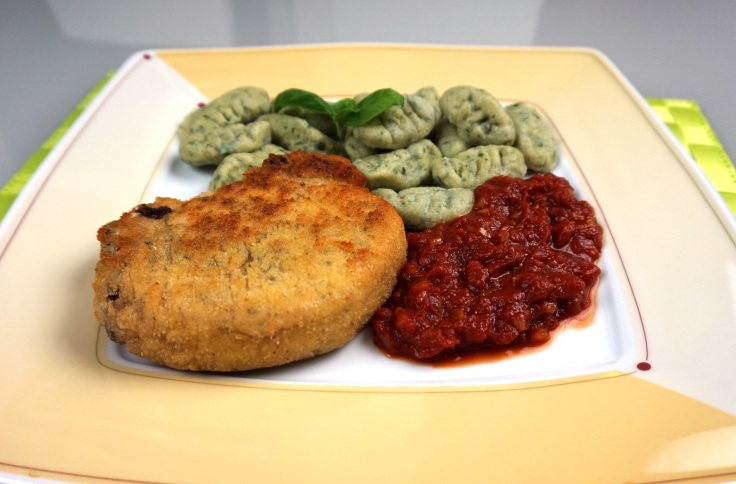
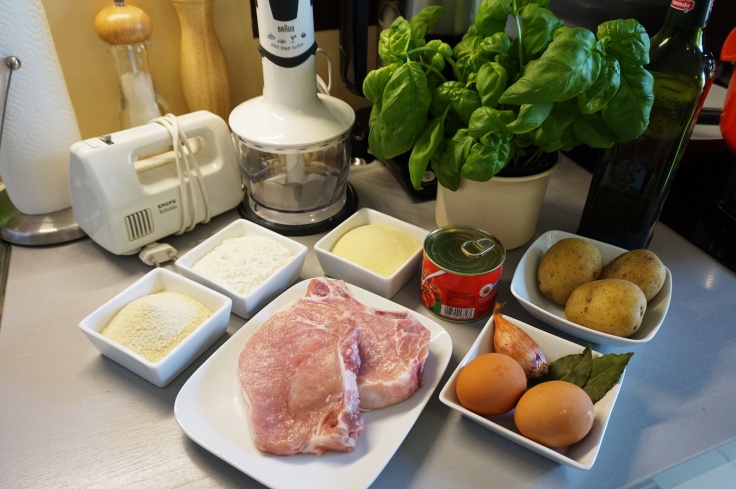


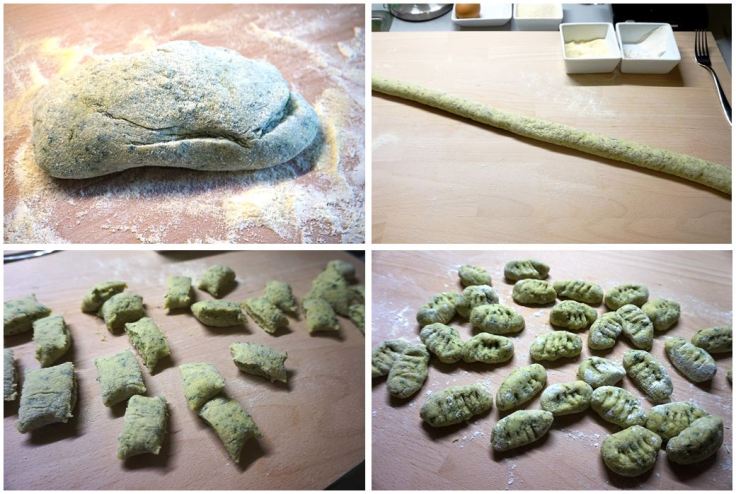
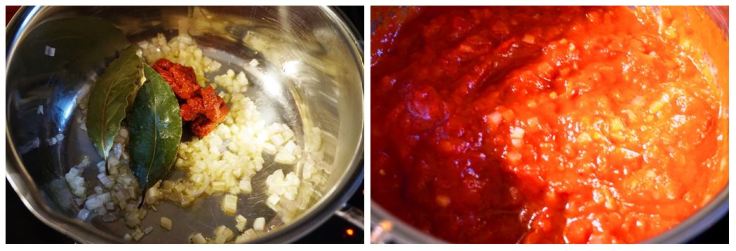

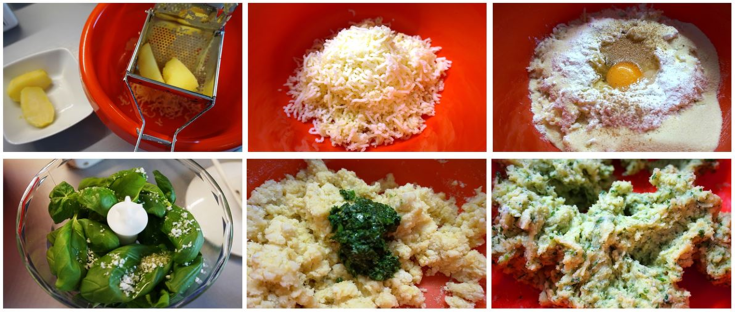
Musst du immer so super leckere Genüsse einstellen? Da werd ich bald die heimische Küche vernachlässigen und nach Italien überlaufen 🙂 Wenn mal ein Buch, Kochbuch der anderen Art lesen möchtest, dann kann ich dir „in Hickenhacken“ von Dario Chissono empfehlen
LikeGefällt 1 Person
Hammer! Das trifft genau meinen Geschmack. Dazu ein schöner Chardonnay aus Italia und ab geht’s! 🙂
LikeGefällt 1 Person